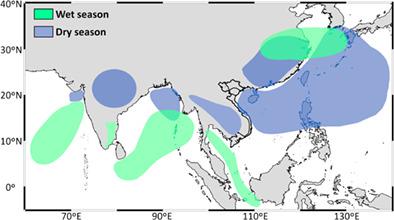当前位置:
X-MOL 学术
›
Int. J. Climatol.
›
论文详情
Our official English website, www.x-mol.net, welcomes your feedback! (Note: you will need to create a separate account there.)
Tracking the origins of moisture over Vietnam: The role of moisture sources and atmospheric drivers on seasonal hydroclimatic conditions
International Journal of Climatology ( IF 3.9 ) Pub Date : 2021-04-27 , DOI: 10.1002/joc.7156 Milica Stojanovic 1 , Raquel Nieto 2 , Margarida L.R. Liberato 1, 3 , Rogert Sorí 1, 2 , Marta Vázquez 1, 2, 3 , Luis Gimeno 2
International Journal of Climatology ( IF 3.9 ) Pub Date : 2021-04-27 , DOI: 10.1002/joc.7156 Milica Stojanovic 1 , Raquel Nieto 2 , Margarida L.R. Liberato 1, 3 , Rogert Sorí 1, 2 , Marta Vázquez 1, 2, 3 , Luis Gimeno 2
Affiliation

|
A Lagrangian approach is used to identify the seasonal climatological moisture sources of the seven climate subregions of Vietnam during 1980–2017. Using the outputs from the FLEXPART model, three main oceanic moisture sources, located in the Arabian Sea, Bay of Bengal, and China Seas, and three terrestrial moisture sources, located in the Indian Peninsula, East Asia, and South Asia, are identified. The most important moisture source during the rainy season (May–October) is the Bay of Bengal, followed by the East Asia continental source for the North-East and North Plain subregions, while for the remaining sub-regions Arabian Sea is the main source. For the dry season (November–April), the China Sea supplies more than the half of the total moisture over almost all subregions, while the continental South Asia source is the primary one for the North-West subregion. The moisture contributions from oceanic moisture sources are the major contributions to the Vietnam subregions, except for the North-West subregion where the terrestrial sources form the major percentage. Severe and extremely dry conditions are identified for both the rainy and dry seasons in all subregions using the 6-month Standardised Precipitation Evapotranspiration Index (SPEI6), and a positive significant linear relationship is found between the SPEI6 time series and the anomalies of moisture contribution from the sources. Thus, for both seasons, a reduction in moisture supply from the most important sources is found during severe and extreme droughts. The dependence on ENSO phase is also assessed. Finally, although the correlations are not statistically significant, we found that the rainy (dry) season in the northern subregions show a tendency towards wetting (drying), while the opposite was found for the southern subregions. This behaviour is consistent with the trends observed in precipitation, potential evapotranspiration, and moisture contribution values from the different sources.
更新日期:2021-04-27



























 京公网安备 11010802027423号
京公网安备 11010802027423号